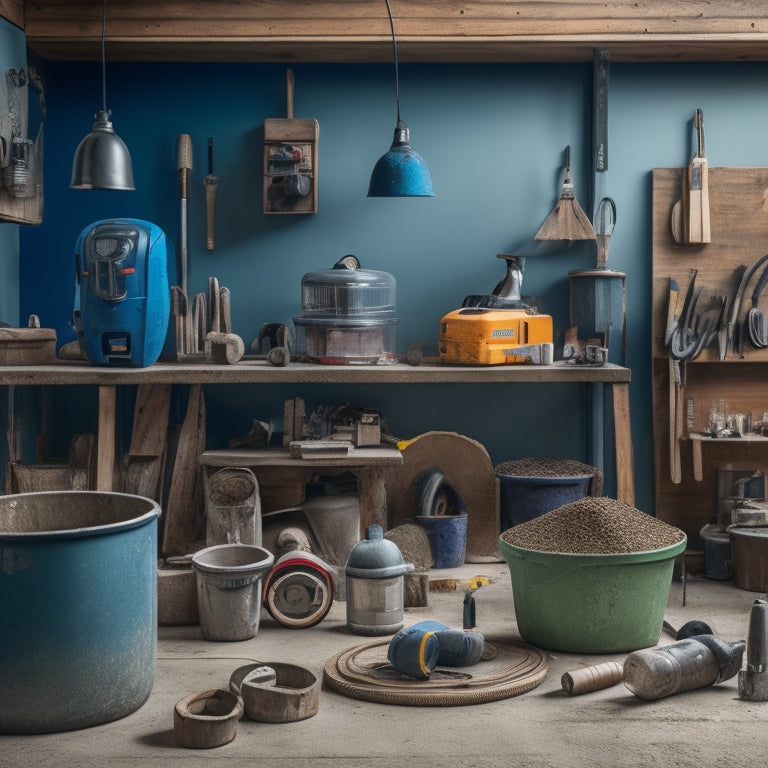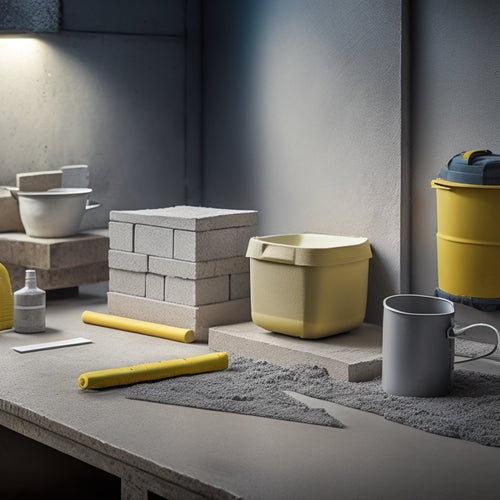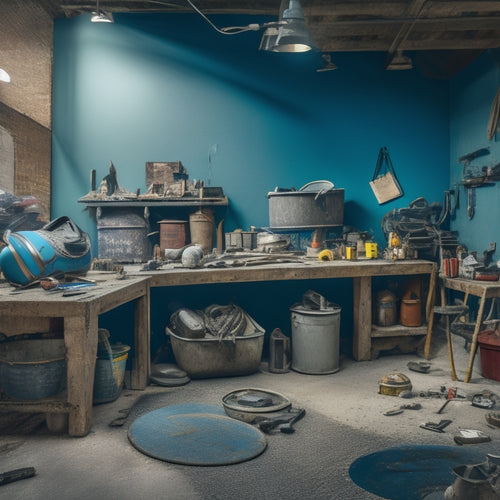
3 Best DIY Tools for Homeowners' Concrete Projects
Share
When tackling concrete projects, you'll need the right tools to achieve professional-looking results. For concrete projects, you should prioritize a circular saw, concrete mixer, and finishing trowel. The circular saw is ideal for straight cuts, while the concrete mixer guarantees a uniform mixture of cement, sand, and water. The finishing trowel, meanwhile, helps you apply and smooth out the concrete. With these three essential tools, you'll be well on your way to completing your project. Now that you have the basics covered, you can move on to more advanced techniques and refine your skills.
Key Takeaways
• A circular saw is ideal for straight cuts in lumber, making it a versatile tool for concrete projects involving wood forms.
• A finishing trowel is essential for applying and smoothing out concrete, ensuring a professional-looking finish.
• A level is crucial for maintaining straight and level block alignment, preventing costly mistakes and ensuring structural integrity.
Essential Cutting and Shaping Tools
You'll need a variety of essential cutting and shaping tools to tackle common DIY projects and repairs around the house.
When it comes to saws, you'll want to have a mix of handheld and stationary options. A circular saw is perfect for making straight cuts in lumber, while a reciprocating saw is ideal for demo work and curved cuts. A jigsaw, on the other hand, is great for precision cuts in curves and irregular shapes. Don't forget a miter saw for precise angled cuts and a bandsaw for resawing lumber.
In addition to saws, you'll need a range of shaping techniques in your toolkit. A router is perfect for creating decorative edges and profiles, while a sander is vital for smoothing out rough surfaces. A planer will help you flatten and thickness lumber, and a jointer will guarantee your boards are square and true.
With these cutting and shaping tools at your disposal, you'll be well-equipped to tackle a wide range of DIY projects and repairs, from building a deck to installing new flooring.
Mixing and Laying Block Tools
With your cutting and shaping tools in place, it's time to focus on the next stage of your DIY project, where mixing and laying block tools come into play. Now, you'll need to prepare the concrete mixture and lay the blocks with precision and accuracy.
To guarantee a strong and durable structure, it is crucial to master mixing techniques and block alignment. Here's a breakdown of the essential tools you'll need:
| Tool | Description |
|---|---|
| Concrete Mixer | A drum-based mixer that combines cement, sand, and water to create a uniform mixture |
| Tamping Tool | A handheld tool used to compact and level freshly laid concrete |
| Level | Confirms the block alignment is straight and level |
| Block Laying Trowel | A flat, wide tool used to spread and smooth out the concrete mixture |
| String Line | A guide that helps maintain a straight line when laying blocks |
Finishing and Smoothing Tools
As you shift from laying blocks to finishing your DIY project, a set of specialized tools is required to smooth and refine the concrete surface, guaranteeing a professional-looking result.
Finishing and smoothing tools are vital for achieving a smooth, even finish. You'll need a range of trowels, including a finishing trowel, edger, and corner trowel, to apply and smooth out the concrete. Mastering trowel techniques is essential for a successful finish.
Before applying the final layer of concrete, verify proper surface preparation by cleaning the area of any debris or excess material. A float or darby is necessary for flattening and leveling the surface, while a steel trowel helps to remove excess water and achieve the desired finish.
An edger is used to create clean edges and corners, and a jointer or groover is required for creating control joints. With the right finishing and smoothing tools, you'll be able to achieve a professional-looking result that's both durable and aesthetically pleasing.
Frequently Asked Questions
How Do I Ensure Proper Ventilation When Working With Concrete Indoors?
When working with concrete indoors, you'll want to guarantee proper ventilation to avoid inhaling hazardous dust and fumes.
Implement ventilation techniques like opening windows and doors, using fans to circulate air, and installing a dust collector or air scrubber.
Prioritize indoor safety by wearing a respirator, safety glasses, and gloves.
Also, mix and apply concrete in well-ventilated areas, and avoid using power tools that generate excessive dust.
Can I Use DIY Concrete Tools for Large-Scale Construction Projects?
When taking on large-scale construction projects, you'll likely need more than DIY concrete tools. While they're perfect for small-scale projects, professional equipment is a must for larger jobs.
You'll require heavy-duty machinery and specialized tools to handle the increased demand.
Don't risk compromising the project's quality or your safety by relying solely on DIY tools. Invest in professional equipment to guarantee a successful and efficient project outcome.
What Safety Gear Is Essential for Protecting Myself From Concrete Dust?
As you step into the world of concrete projects, remember that a cloud of dust can be a storm that blinds and chokes.
You must shield yourself from the treacherous concrete dust that can silently creep into your lungs.
Don't take a breath without a dust mask, and safeguard your eyes with protective eyewear.
These essential safety gears will be your armor against the hazardous particles, allowing you to build with confidence and care.
How Do I Store and Maintain My DIY Concrete Tools Properly?
You'll want to prioritize tool organization and maintenance to guarantee your DIY concrete tools remain in top condition.
Designate a specific area for storage, keeping frequently used tools within easy reach.
Regularly clean and inspect your tools, replacing worn or damaged parts as needed.
Apply lubricants to moving parts and store them in a dry, protected area.
Are There Any Eco-Friendly Alternatives to Traditional Concrete Materials?
Imagine a world where construction and sustainability coexist in harmony.
As you venture into eco-friendly alternatives, you'll find sustainable concrete made from recycled aggregates, reducing waste and conserving natural resources.
You're not sacrificing strength for eco-friendliness, either - these alternatives often boast comparable compressive strength to traditional concrete.
Conclusion
With these top-tier tools in your toolkit, tackling concrete projects becomes a tangible triumph.
Crafted cuts, seamless shapes, and silky smooth finishes are now within your grasp.
Conquer concrete chaos with confidence, precision, and control.
Your DIY dreams are destined to dazzle, as you explore durable, dependable, and dazzling concrete creations that will leave a lasting legacy.
Related Posts
-

Smart Guide to Buying Used Concrete Hand Tools
You're about to buy used concrete hand tools, and you need to get it right. Dedicate time to identify the tools you n...
-

What Tools Do I Need for Concrete Block Laying
You'll need a thorough set of tools to guarantee accurate, efficient, and professional concrete block laying. Essenti...
-

What Tools Do You Need for Concrete Flooring
You'll need a thorough arsenal of specialized tools to achieve a high-quality, professional-looking concrete floor, i...


